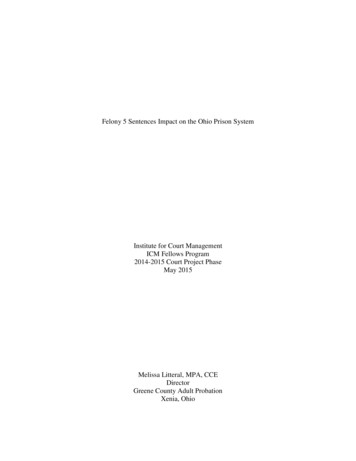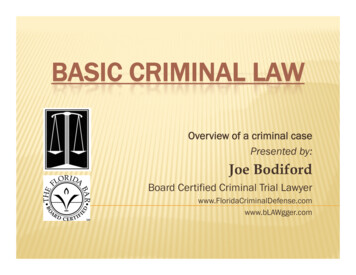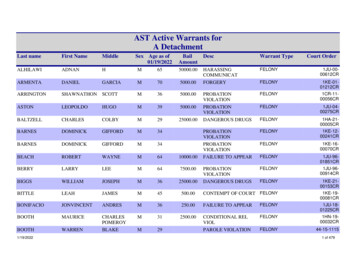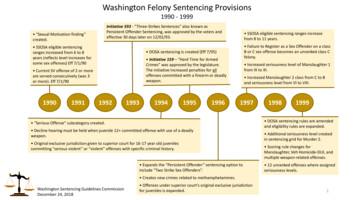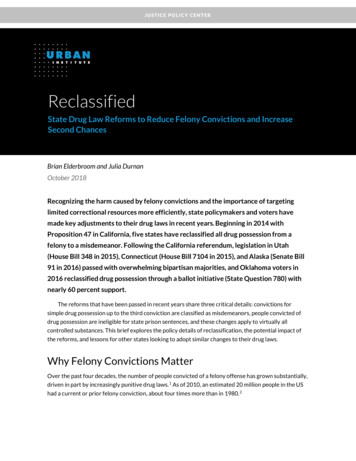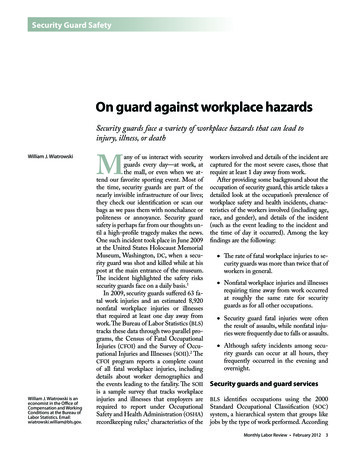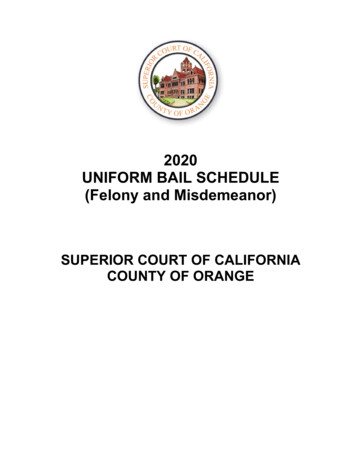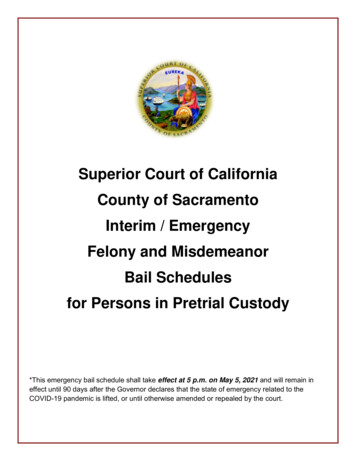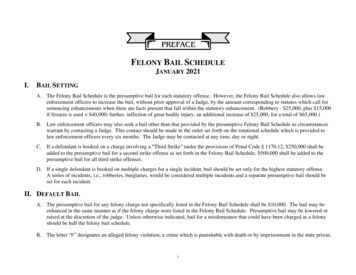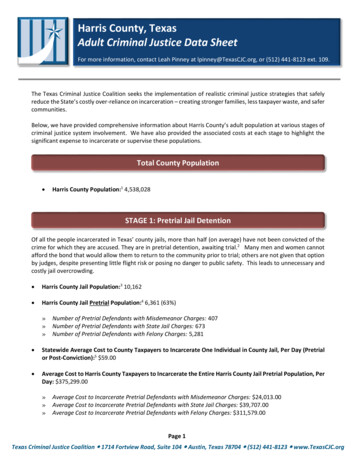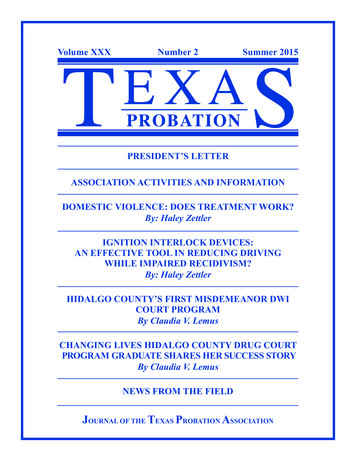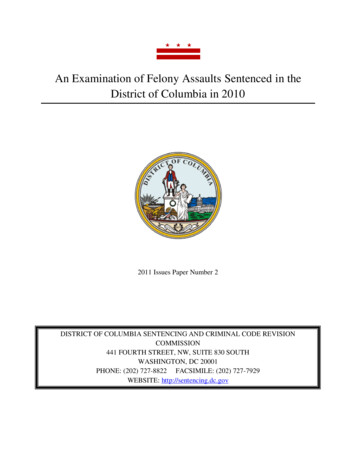
Transcription
An Examination of Felony Assaults Sentenced in theDistrict of Columbia in 20102011 Issues Paper Number 2DISTRICT OF COLUMBIA SENTENCING AND CRIMINAL CODE REVISIONCOMMISSION441 FOURTH STREET, NW, SUITE 830 SOUTHWASHINGTON, DC 20001PHONE: (202) 727-8822 FACSIMILE: (202) 727-7929WEBSITE: http://sentencing.dc.gov
Mission StatementThe mission of the District of Columbia Sentencing and CriminalCode Revision Commission is to implement, monitor, and supportthe District’s voluntary sentencing guidelines, to promote fairand consistent sentencing policies, to increase publicunderstanding of sentencing policies and practices, and toevaluate the effectiveness of the guidelines system in or der torecommend changes based on actual sentencing and correctionspractice and research.
MEMBERSHIP OF THE DISTRICT OF COLUMBIA SENTENCING AND CRIMINAL CODE REVISION COMMISSIONThe Honorable Frederick H. WeisbergSuperior Court of the District of ColumbiaThe Honorable Harold L. CushenberrySuperior Court of the District of ColumbiaThe Honorable J. Ramsey JohnsonSuperior Court of the District of ColumbiaDonald Braman, Ph.D.George Washington University School of LawRonald Gainer, Esq.Attorney, Private PracticeLaura E. Hankins, Esq.Public Defender Service for the District of ColumbiaAdele V. Harrell, Ph.D.Urban Institute, Justice Policy CenterCedric Hendricks, Esq.Court Services & Offender Supervision AgencyPatricia A. Riley, Esq.U.S. Attorney‘s OfficeMichele Roberts, Esq.Attorney, Private PracticeDavid Rosenthal, Esq.Office of Attorney General, District of ColumbiaJulie E. SamuelsUrban Institute, Justice Policy CenterJennifer Seltzer StittCitizen MemberAnne SeymourCitizen MemberEarl J. Silbert, Esq.Attorney, Private PracticeMaria Amato**D.C. Department of CorrectionsMichael Anzallo**D.C. Metropolitan Police DepartmentStephen J. Husk**United States Parole CommissionThomas R. Kane, Ph.D.**Federal Bureau of PrisonsThe Honorable Phil Mendelson**Council of the District of Columbia** Non-voting MemberCOMMISSION STAFFBarbara Tombs-SouveyExecutive DirectorKenneth Cowgill, Esq.Attorney AdvisorMegan E. CollinsResearch AnalystCourtni Y. Burleson, Esq.Staff AttorneyThurman Sanders IVData Management SpecialistMia HebbStaff Assistant
During the 2010 calendar year, 363 sentences were imposed for felony-level assaults in theDistrict of Columbia. These offenses are of particular concern given the harm inflicted onvictims, and threat to safety in the community. Data analyzed by the Commission show that 299offenders were responsible for the 363 assault counts, as numerous offenders were sentenced onmultiple assault counts.1 Assaults represented 43.4% of violent felony2 counts sentenced in 2010(n 836) and 8.4% of all felony counts sentenced (n 4,329). Of the violent felony offensessentenced in 2010, assaults were among the most common, only second in number to robbery(Figure 1). As expected, the most serious violent offenses, murder and manslaughter,(collectively referred to as homicide) were significantly fewer in number than assaults.This paper investigates offender characteristics and sentencing patterns for all types of felonyassaults sentenced in 2010, with the purpose of determining how the D.C. Voluntary SentencingGuidelines are applied to assault offenses in the District. The data utilized in this report includeall felony sentences imposed in the District of Columbia between January 1 and December 31,2010, regardless of when the initial offense occurred. This information was provided to theCommission by the Court Services and Offender Supervision Agency (CSOSA), and the Districtof Columbia Superior Court.Figure 1: Violent Felony Offenses Sentenced in 2010, (N 836)RobberyAssaultHomicideKidnappingCruelty to Children3843677694Overview of AssaultsFelony assault offenses are defined in the D.C. Official Code § 22-401 through § 22-406. Whileeach statute under the encompassing term of ―assault‖ contains its own unique elements, thereare certain criteria present in all assaults:i.the offender injured 3 (or attempted to injure) the victim with force or violence;1A single case may be composed of numerous criminal counts—both felony and misdemeanor. Single offendersmay be sentenced for multiple felony assault counts within a single case, and may even be sentenced for numerouscases within a single year. This paper thus specifies which unit of analysis (count, case, or offender) is beingmeasured at a given time.2For the purpose of this report, ―violent‖ offenses refer to crimes involving the use, attempted use, or threatened useof physical force against another, or events involving serious potential risk of physical harm; however, this reporttreats violent crimes and property crimes as being mutually exclusive, and therefore does not include offenses suchas arson, extortion, or burglary under the ―violent‖ crime classification.3Per the 2010 Criminal Jury Instructions § 4.100: in the case of assault, ―injury‖ refers to any physical harm,including touching (if considered offensive to a reasonable person). Barbara E. Bergman, Criminal JuryInstructions for the District of Columbia (Matthew Bender, Rev. Ed.).1
ii.iii.s/he did so voluntarily, on purpose, and not by mistake or accident; andat the time, the offender had the apparent ability to injure the complainant.Additional elements are involved in cases of assaults that occur with weapons present or duringthe commission of another felony, and in cases of Aggravated Assault. An Aggravated Assaultoccurs if ―circumstances manifesting extreme indifference to human life, [the offender] created a grave risk of serious bodily injury to [victim].‖4 The present examination focusesspecifically on assaults that involved serious injury, or risk thereof, and does not include casesthat resulted in death (e.g. murder or manslaughter).Eighteen different types of felony assault were sentenced in the District of Columbia in 2010.The two most common assaults sentenced were Assault with a Dangerous Weapon, 5 and Assaultwith Significant Injury6 (Figure 2); together these two offenses accounted for 59.5% of allassaults sentenced. Other noteworthy sentencing trends involved counts of Aggravated Assaults(including attempted and while armed counts; 10.2%), and felony assaults directed at lawenforcement officials (8.8%).Additionally, half of all assault charges sentenced in 2010 occurred while the offender wasarmed.7 The most common weapons used in felony assaults in the District of Columbia includedfirearms and knives, although one case reported the use of a glass bottle as a weapon. Victims ofboth armed and unarmed assaults experienced a varied range of injuries including stab wounds,broken bones, gunshot wounds, lacerations, and bite wounds.Guidelines for Sentencing AssaultsThe D.C. Voluntary Sentencing Guidelines are a comprehensive structured system that providesfelony sentencing recommendations based on an offender‘s criminal history and the severity ofhis/her offense. Conformity to the Guidelines begins with identifying the appropriate sentencingbox for a particular felony offense on the Master Grid or the Drug Grid. 8 Each box reflects theintersection of the Offense Severity Group for the crime and the criminal history score of the4Barbara E. Bergman, Criminal Jury Instructions for the District of Columbia (Matthew Bender, Rev. Ed.).Per the 2010 Criminal Jury Instructions § 4.101: an object is considered a dangerous weapon if it designed to beused, actually used, or threatened to be used, in a manner likely to produce death or serious bodily injury.Voluntarily pointing a dangerous weapon at another person in a threatening manner, or voluntarily using it in a waythat would reasonably create in the other person a fear of immediate injury, would be an assault with a dangerousweapon.6Per the 2010 Criminal Jury Instructions §§ 4.102, 4.103: ―Significant injury‖ is defined as an injury that requireshospitalization or immediate medical attention. See also D.C. Code § 22-404(a)(2). This is different than thestandard for Aggravated Assault which involves ―serious bodily injury‖ or an injury that involves unconsciousness,extreme physical pain, protracted and obvious disfigurement, protracted loss or impairment of the function of abodily member, organ or mental faculty or a substantial risk of death. See Nixon v. U.S., 730 A.2d 145, 150 (D.C.1999). Assault with Significant Injury is also referred to as ―Felony Assault.‖7Armed assaults were identified for 182 counts by ―while armed‖ and ―with a dangerous weapon‖ distinctions; it ispossible that other offenses also occurred with a weapon, but the weapon offense was charged separately.8All felony assault offenses with Offense Severity Group rankings are found on the Master Grid.52
offender. The Offense Severity Group for each conviction by plea or verdict is determined by itsranking within the Guidelines, which group felony offenses according to their severity level (themore serious an offense, the lower the severity group number). The criminal history score isdetermined by a series of Guidelines rules, which primarily account for the type, number, andseverity of prior convictions and also the length of time between the imposition or expiration ofthe offender‘s last sentence and the commission of the instant offense.9Based upon Offense Severity Group, the most serious assaults sentenced in 2010 were 14 countsof Assault with Intent to Kill While Armed, while the least serious assaults involved 150 countsranked in Master Group 8. Among the least serious assaults sentenced were Assault withSignificant Injury, and various forms of Attempted Assault (Figure 2). The majority of assaultssentenced fell into the Master Group 6 (41.3%) and Master Group 8 (34.7%) Offense SeverityGroups. Thus, although assault offenses may be ranked as high as a ―M3,‖ the majority ofassault counts sentenced actually fell into the lower half of the Master Grid Offense SeverityGroups.9Specific provisions governing Offense Severity Groups and criminal history scoring under the Guidelines can befound in the Voluntary Sentencing Guidelines Manual, available at http://sentencing.dc.gov.3
Figure 2: FY 2010 Assault Offender Characteristics,10 by CountGender (N)Assault withIntent to KillWhile ArmedAggravatedAssault WhileArmedAssault withIntent to Commit1 or 2 SexAbuse WhileArmedAssault withIntent to KillAssault withIntent to RobWhile ArmedMaliciousDisfigurementWhile ArmedAssault on aPolice OfficerWhile ArmedAggravatedAssaultAssault with aDangerousWeaponAssault withIntent to CommitChild Sex AbuseAssault withIntent to Commit1 or 2 SexAbuseAssault withIntent to RobMaliciousDisfigurementAssault on aPolice OfficerAssault emptedAssault with aDangerousWeaponAttemptedAssault withIntent to KillTotalRace (N)Sentence Type nses on the table are ordered by Offense Severity Group, with the most serious offenses listed first.* 100% of counts for this offense were sentenced to prison in 2010.4
Sentenced Assault OffendersThe overwhelming majority of felony assault offenders sentenced in 2010 were male (87.6%)and Black (96.7%), thus it follows that 84.3% of assault offenders were Black males (n 252).This is consistent with the overall 2010 D.C. felony sentencing trends, as Black males (n 2,496)accounted for 82.6% of all felony sentences imposed. The percent of female offenders sentencedfor felony assaults was 1.7 percentage points less than the percent female for all felonyoffenders.Figure 3: Race and Gender of Assault Offenders in er/Unknown0.70%Other/Unknown0.30%The most frequent age category for an individual sentenced for an assault charge was between18.0 and 22.9; this trend was also consistent for the two most common types of assault: Assaultwith a Dangerous Weapon, and Assault with Significant Injury (Figure 4). The average age ofall assault offenders was 28.87 (Figure 2, page 3), which is higher than the most common agerange due to the absence of a maximum age ceiling. However, following the 18.0 to 22.9 agegroup, there is a drastic drop-off in the percent of felony assault sentences for all offenders, aswell as the two most common types of assaults.Figure 4: Age of Offenders for Most Common Assaults Sentenced in 201035.0%30.0%25.0%20.0%15.0%10.0%5.0%0.0%Assault With A Dangerous WeaponAssault With Significant InjuryTotal 2010 Assaults4
Types of Assault DispositionsConsistent with overall felony and violent crime disposition patterns, the majority of felonyassault cases sentenced were the result of plea negotiations. However, the rate of jury trials forfelony assault cases was 10 percentage points higher than was typical for all felonies in general.Assault cases were also about 3 percentage points more likely to experience a jury trial than wasseen for all violent felony cases. It is not possible to do a comparison of bench trials across thethree groups in Figure 5, given how infrequently they occurred.Figure 5: Distribution of Trial Dispositions in 2010, by Case100.00%3,103570 233Percent of Cases80.00%60.00%40.00%10720.00%5327416320.00%Plea NegotiationFelony CasesJury TrialViolent Crime CasesBench TrialAssault CasesTypes of SentencesConsistent with both violent crime and total felony sentencing trends, the majority of convictedassault counts resulted in the imposition of a prison sentence. Short split sentences 11 were theleast common for all felony offenses, as well as for violent crimes, and assaults. Notsurprisingly, incarceration rates were higher for both violent crime and felony assault countswhen compared to overall felony sentencing patterns for 2010. The ―Felony Cases‖ categoryexperienced a higher rate of probation sentences than both Violent Crime and Assault Cases.This difference is likely due to the high volume of probation imposed for felony drug offenses(34.1%), which are not included in the other two groups. Additionally, 11 of the 18 differenttypes of felony assaults sentenced in 2010 resulted in prison sentences being imposed 100% ofthe time (Figure 2, page 3).11Short split sentences are defined as a brief period of incarceration (six months or less) followed by probation.5
Figure 6: Distribution of 2010 Assault Counts on the Master Grid 12Criminal History ScoreRankingGroupGroup 1Group 2Group 3Group 4Group 5Group 6Group 7Group 8SentenceTypePrisonPrisonPrisonPrisonShort SplitProbationPrisonPrisonShort SplitProbation0 to 0.5A0.75 to 1.75B2.0 to 3.75C56436111124820475371431282264116864.0 to 5.75D36.0 E81510241265631721Group 9TotalTotal001320151191211811526030313Of the 48 offenders sentenced for Master Group 6 offenses who qualified for short splitsentences based on their criminal history score, 75% received prison sentences. Similarly, 63%of offenders with Master Group 8 offenses who qualified for probation and/or short splitsentences received prison. Thus it appears that assault counts result in prison sentences moreoften than not, even when other options are permissible.The average length of incarceration for felony assault counts was 50.15 months, with a mediansentence length of 30 months for prison sentences. These sentence lengths are slightly lowerthan sentence lengths for all violent crimes, which had average and median prison sentences of64.9 and 33.0 months, respectively. This difference is the result of the highest assault OffenseSeverity Group being ranked on Master Group 3 (Assault with Intent to Kill While Armed),which is lower than the highest offense group for all violent crimes is Master Group 1 (FirstDegree Murder).Compliance with the GuidelinesJudicial compliance with the District‘s Voluntary Sentencing Guidelines appears to beexceptionally high when sentencing felony assaults. Of the 303 counts of felony assault forwhich criminal history scores were available, 297 had sentences that were both durationally and12White/unshaded boxes – prison onlyDark shaded boxes – prison or short split permissibleLight shaded boxes – prison, short split, or probation permissible13Although 363 sentences were imposed for felony assault sentences in 2010, criminal history information was onlyavailable for 303.6
dispositionally compliant14 or utilized an authorizedaggravating or mitigating departure factor. Thus, for felonyassault cases, at least 98% of the 303 counts with criminalhistory scores followed the Guidelines. 15Of the four counts that were sentenced using an authorizeddeparture factor, Mitigating Factor #1016 was used for threecounts. This specific departure factor results in a sentencethat is below the designated range. The circumstancessurrounding the three cases for which this factor was appliedwere all different, and included the offenders‘ rehabilitativeefforts, over-representation of criminal history, and the roleplayed by other offenders. Aggravating Factor #317 was usedonce in the case of a devastating injury, and resulted in asentence that was above the Guidelines‘ designated sentencerange.Comparison to Other Urban RegionsFocus on Young OffendersThirteen individual offenderswere in the youngest age group(16.1-17.9) and were responsiblefor a total of 24 felony assaultcharges. These offenses involvedtwelve counts of Assault with aDangerous Weapon, four countsof both Assault with SignificantInjury and Assault with intent toKill While Armed, three countsof Aggravated Assault WhileArmed, and one count of Assaultwith Intent to Rob While Armed.Ten of the thirteen cases weredisposed of by plea negotiation,while the remaining threeinvolved jury trials. All thirteenyouths were incarcerated, withimprisonment ranging from 8 to156 months, with an averagesentence length of 49.58 months.In general, felony assault sentencing trends are consistentwith overall felony sentencing practices in the District ofColumbia for 2010, as well as with felony assault sentencingtrends in other large urban counties throughout the United States, as reported by the Bureau ofJustice Statistics (BJS).18 Assaults comprised 8.5% of all felony counts sentenced in the Districtin 2010, which is fairly consistent with the 10.1 to 12.0% of all lead charges nationwide. In largeurban counties 76% of felony assault convictions resulted in incarceration; D.C. assault offenderswere incarcerated at a higher rate, with 82% of counts receiving prison sentences. Almost allassault offenders in the District were under the age of 30, which is slightly below the nationwideaverage of 32.0 years of age.14Compliance with the D.C. Voluntary Sentencing Guidelines requires that a sentence fall within the range stated inthe appropriate grid box, and follow the rules depicted by the box shading. Sentences are also considered compliantif they fall outside the grid box, but the judge provides an aggravating or mitigating reason for doing so.15Compliance is unknown for four counts which were determined to be outside the box, as Compliance Surveyswere not returned by the sentencing judge; 98% is a conservative figure, as it assumes non-compliance for theunknown counts.16Mitigating Factor #10: ―There is any other substantial and compelling basis, as articulated by the sentencingjudge, comparable in gravity to those listed in 1 to 9 above, which does not amount to a defense, but whichsubstantially mitigates the seriousness of the offense or the defendant‘s culpability.‖17Aggravating Factor #3: ―A victim sustained a ‗devastating injury.‘ Devastating injury is defined as a physical ormental injury that results in one or more of the following: (a) permanent and substantial impairment of the person‘semployment opportunity and/or lifestyle; (b) permanent, gross disfigurement; or (c) medical confinement and/orimmobilization for a period of more than three months.‖18Cohen, T.H., & Kyckelhahn, T. (2010), Felony Defendants in Large Urban Counties, 2006. Bureau of JusticeStatistics Bulletin, NCJ 228944, 1-41.7
Key FindingsFelony assaults are common among violent offenses sentenced in the District, and aretypically Assault with a Dangerous Weapon or Assault with Significant Injuries. Morethan half of these offenses occur while the offender is armed.Assault offenders sentenced most frequently in the District are Black males in theirtwenties; the majority of these offenders are sentenced to prison, upon conviction.Judicial compliance is exceptionally high with at least 98% of felony assault offensessentenced in accordance with the D.C. Voluntary Sentencing Guidelines.8
Contact Information:District of Columbia Sentencing and Criminal Code Revision Commission441 4th Street, N.W.Suite 830 SouthWashington, DC 20001Office: (202) 727-8822Fax: (202) 727-7929Email: sccrc@dc.govWebsite: http://sentencing.dc.gov
1 A single case may be composed of numerous criminal counts—both felony and misdemeanor. Single offenders may be sentenced for multiple felony assault counts within a single case, and may even be sentenced for numerous cases within a single year. This paper thus specifies which unit of analysis (count, case, or offender) is being
